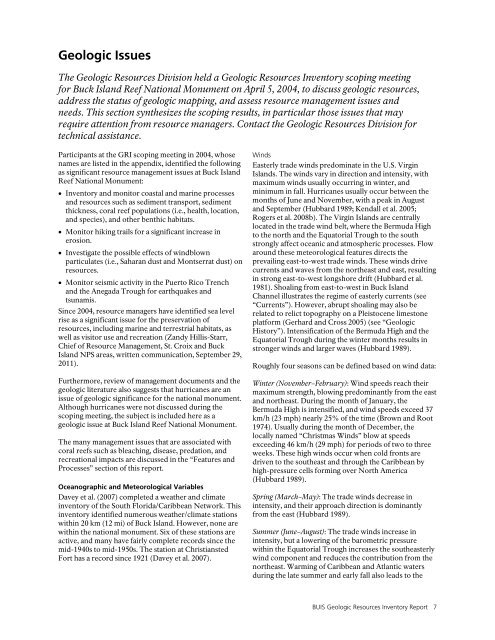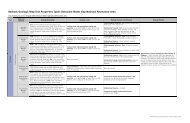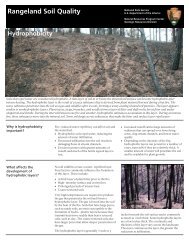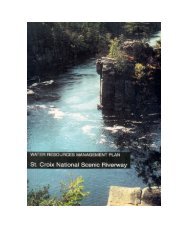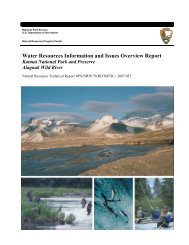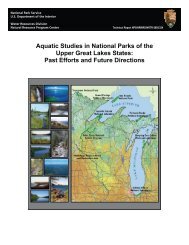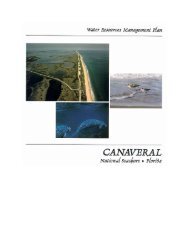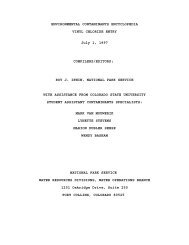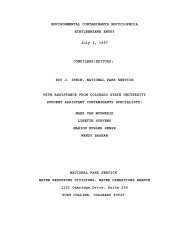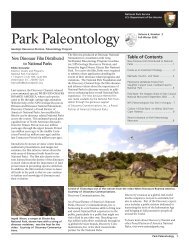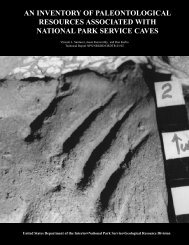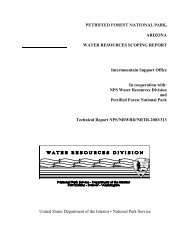Buck Island Reef National Monument Geologic Resources Inventory
Buck Island Reef National Monument Geologic Resources Inventory
Buck Island Reef National Monument Geologic Resources Inventory
You also want an ePaper? Increase the reach of your titles
YUMPU automatically turns print PDFs into web optimized ePapers that Google loves.
<strong>Geologic</strong> Issues<br />
The <strong>Geologic</strong> <strong>Resources</strong> Division held a <strong>Geologic</strong> <strong>Resources</strong> <strong>Inventory</strong> scoping meeting<br />
for <strong>Buck</strong> <strong>Island</strong> <strong>Reef</strong> <strong>National</strong> <strong>Monument</strong> on April 5, 2004, to discuss geologic resources,<br />
address the status of geologic mapping, and assess resource management issues and<br />
needs. This section synthesizes the scoping results, in particular those issues that may<br />
require attention from resource managers. Contact the <strong>Geologic</strong> <strong>Resources</strong> Division for<br />
technical assistance.<br />
Participants at the GRI scoping meeting in 2004, whose<br />
names are listed in the appendix, identified the following<br />
as significant resource management issues at <strong>Buck</strong> <strong>Island</strong><br />
<strong>Reef</strong> <strong>National</strong> <strong>Monument</strong>:<br />
• <strong>Inventory</strong> and monitor coastal and marine processes<br />
and resources such as sediment transport, sediment<br />
thickness, coral reef populations (i.e., health, location,<br />
and species), and other benthic habitats.<br />
• Monitor hiking trails for a significant increase in<br />
erosion.<br />
• Investigate the possible effects of windblown<br />
particulates (i.e., Saharan dust and Montserrat dust) on<br />
resources.<br />
• Monitor seismic activity in the Puerto Rico Trench<br />
and the Anegada Trough for earthquakes and<br />
tsunamis.<br />
Since 2004, resource managers have identified sea level<br />
rise as a significant issue for the preservation of<br />
resources, including marine and terrestrial habitats, as<br />
well as visitor use and recreation (Zandy Hillis-Starr,<br />
Chief of Resource Management, St. Croix and <strong>Buck</strong><br />
<strong>Island</strong> NPS areas, written communication, September 29,<br />
2011).<br />
Furthermore, review of management documents and the<br />
geologic literature also suggests that hurricanes are an<br />
issue of geologic significance for the national monument.<br />
Although hurricanes were not discussed during the<br />
scoping meeting, the subject is included here as a<br />
geologic issue at <strong>Buck</strong> <strong>Island</strong> <strong>Reef</strong> <strong>National</strong> <strong>Monument</strong>.<br />
The many management issues that are associated with<br />
coral reefs such as bleaching, disease, predation, and<br />
recreational impacts are discussed in the “Features and<br />
Processes” section of this report.<br />
Oceanographic and Meteorological Variables<br />
Davey et al. (2007) completed a weather and climate<br />
inventory of the South Florida/Caribbean Network. This<br />
inventory identified numerous weather/climate stations<br />
within 20 km (12 mi) of <strong>Buck</strong> <strong>Island</strong>. However, none are<br />
within the national monument. Six of these stations are<br />
active, and many have fairly complete records since the<br />
mid-1940s to mid-1950s. The station at Christiansted<br />
Fort has a record since 1921 (Davey et al. 2007).<br />
Winds<br />
Easterly trade winds predominate in the U.S. Virgin<br />
<strong>Island</strong>s. The winds vary in direction and intensity, with<br />
maximum winds usually occurring in winter, and<br />
minimum in fall. Hurricanes usually occur between the<br />
months of June and November, with a peak in August<br />
and September (Hubbard 1989; Kendall et al. 2005;<br />
Rogers et al. 2008b). The Virgin <strong>Island</strong>s are centrally<br />
located in the trade wind belt, where the Bermuda High<br />
to the north and the Equatorial Trough to the south<br />
strongly affect oceanic and atmospheric processes. Flow<br />
around these meteorological features directs the<br />
prevailing east-to-west trade winds. These winds drive<br />
currents and waves from the northeast and east, resulting<br />
in strong east-to-west longshore drift (Hubbard et al.<br />
1981). Shoaling from east-to-west in <strong>Buck</strong> <strong>Island</strong><br />
Channel illustrates the regime of easterly currents (see<br />
“Currents”). However, abrupt shoaling may also be<br />
related to relict topography on a Pleistocene limestone<br />
platform (Gerhard and Cross 2005) (see “<strong>Geologic</strong><br />
History”). Intensification of the Bermuda High and the<br />
Equatorial Trough during the winter months results in<br />
stronger winds and larger waves (Hubbard 1989).<br />
Roughly four seasons can be defined based on wind data:<br />
Winter (November–February): Wind speeds reach their<br />
maximum strength, blowing predominantly from the east<br />
and northeast. During the month of January, the<br />
Bermuda High is intensified, and wind speeds exceed 37<br />
km/h (23 mph) nearly 25% of the time (Brown and Root<br />
1974). Usually during the month of December, the<br />
locally named “Christmas Winds” blow at speeds<br />
exceeding 46 km/h (29 mph) for periods of two to three<br />
weeks. These high winds occur when cold fronts are<br />
driven to the southeast and through the Caribbean by<br />
high-pressure cells forming over North America<br />
(Hubbard 1989).<br />
Spring (March–May): The trade winds decrease in<br />
intensity, and their approach direction is dominantly<br />
from the east (Hubbard 1989).<br />
Summer (June–August): The trade winds increase in<br />
intensity, but a lowering of the barometric pressure<br />
within the Equatorial Trough increases the southeasterly<br />
wind component and reduces the contribution from the<br />
northeast. Warming of Caribbean and Atlantic waters<br />
during the late summer and early fall also leads to the<br />
BUIS <strong>Geologic</strong> <strong>Resources</strong> <strong>Inventory</strong> Report 7


